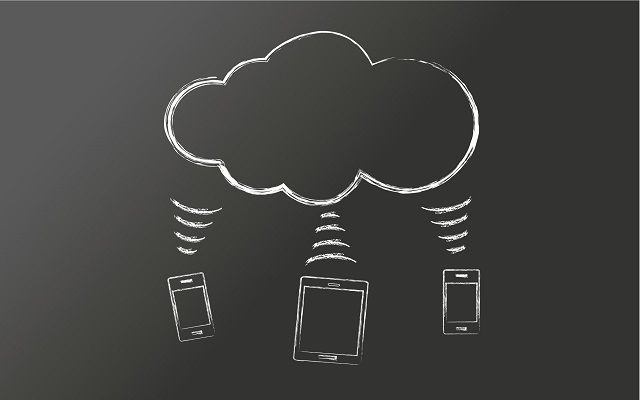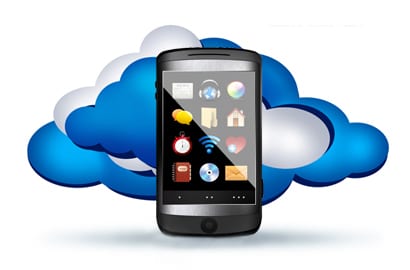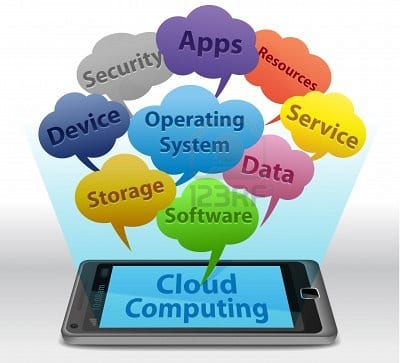The Mobile Cloud An Important Cog In The Cloud Computing Engine

Cloud computing is the latest business buzzword, and is also known as cloud technology, cloud applications, or cloud-based services. Cloud computing is where apps or data are accessible on the Internet instead of on a single computer or network. Examples of cloud-based services include customer self-scheduling, data storage, online payment, and accounting software.
Cloud computing comes into focus only when you think about what IT always needs: a way to increase capacity or add capabilities on the fly without investing in new infrastructure, training new personnel, or licensing new software. Cloud computing encompasses any subscription-based or pay-per-use service that, in real time over the Internet, extends IT’s existing capabilities.
MOBILE CLOUD COMPUTING:
Mobile Cloud Computing is also directly impacted by the above trend and according to Juniper Research more than 240 million business customers will access cloud computing services via mobile devices by 2015. This incorporates many elements, including consumer, enterprise, femtocells, transcoding, end-to-end security, home gateways, and mobile broadband-enabled services
Companies are being driven to the mobile cloud by demand. Customers are demanding smart phone and tablet applications so they can access companies’ key applications. Employees are demanding access from their mobile devices. BlackBerry capitalized on this need with its popular cloud-based mobile e-mail program.
Work patterns and habits are also changing because of the mobile cloud. Experts surveyed by the Pew Internet Project think that by 2020, most people who use the Internet will work primarily through cyberspace-based applications on remote servers accessed through networked devices. Increased access to company computing assets also brings an increased security risk, however. Companies are now considering data use policies. For example, geolocation data available from a mobile platform might allow access to be declined if a mobile user is out of the country. Security already implemented by cloud providers is one more available service that customers can configure to satisfy their enhanced security policies.
Along with changing patterns and work habits, the mobile ecosystem consists of many devices. IBM predicts that by 2015, there will be 1 trillion cloud-ready devices. The opportunities seem to be endless for exploiting the information those devices will be able to generate. One current example is offered by parking structures employing smart parking meters that can send messages to drivers about empty spaces.
Another trend points to the mobilization of money through the mobile cloud. For example, the company Tabbed Out has created a service that allows people to use their smart phones to open, review, and pay tabs. Starbucks recently began allowing customers to pay for purchases with an application that accesses the customer’s account and generates an on-screen bar code that the cashier scans to complete the payment. The customer’s Starbucks account is replenished with a credit card or PayPal account.
The mobile cloud is set to become an important cog in the cloud computing engine, particularly with the explosion of mobile devices such as smart phones and tablets that make simplified accessibility to information a major business consideration. Mobile cloud computing extends cloud computing by providing enhanced service availability and by exploiting information about a user’s location, context and network intelligence, thereby considerably improving user experience. Leveraging the mobile device storage, sensing and processing resources for optimizing cloud-based application also adds to better user experience.
The mobile cloud also comes with its own particular set of challenges that companies should be aware of from the get-go to ensure that they are fully abreast of what it takes to adopt the mobile counterpart of the information strata.
Cloud computing is at an early stage, with a motley crew of providers large and small delivering a slew of cloud-based services, from full-blown applications to storage services to spam filtering.
Mobility in the cloud is fundamentally a hosted, centralized offering that runs mobile enterprise extensions and services in a virtualized environment.
Like its cloud computing counterpart, the mobile cloud is made available through various structures including the pay-per-service or pay-per-use model and is aligned to industry best practices for the provisioning of these services.
These devices are managed – particularly within the context of the private cloud – securely by a hosted environment that is governed by industry standards and up-to-date security solutions.
Also, it offers a flexible, shared service that delivers critical benefits such as saving costs on physical infrastructure implementation and footprint.
Importantly, it also allows for greener IT practices as these numerous mobile devices are now able to access corporate information residing on the cloud remotely.
It therefore takes the spirit and known benefits of cloud computing and adds a layer of mobility to it which extends IT services and accessibility to both corporate workers and private users across the globe. Indeed, it allows for device proliferation in an environment that is secure and managed.
PLATFORM (SMART PHONES):
The application of smart phones in industry and corporate settings is supporting increased sales of cloud and they are relying on cloud for computing.. Previously, the Blackberry was virtually the only accepted corporate Smartphone platform. This is changing fast, as both iPhones and Android (and presumably Windows Phone) is being adopted in corporate settings.
Due to this growth and acceptance of smart phones, contribute heavily to the increasing mobile cloud emphasis. It is however not due only to increasing availability of smart phones and tablets, but also standards and cloud services that support remote data access, storage and apps. Prominent examples include Apple iCloud, Microsoft SkyDrive and DropBox, to name a few. Users are getting used to upload and access their data from the cloud – and increasingly from a mobile device.
In fact, “Vision gain” expects mobile cloud services to reach $45 billion in 2016. The greatest revenue contributions will come from mobile cloud apps, driven by increasing Smartphone penetration, growth of 3G network coverage across the globe and deployment of 4G/LTE services. Furthermore, technology enhancements such as BONDI, OneAPI and HTML5 will further enhance the development of cloud based mobile applications.
From the predictions above it certainly seems that mobile cloud computing has a bright future ahead. Mobile Network Operators (MNOs) are likely to enter the domain with carrier-cloud services that are poised to compete with some of the public cloud offerings through service differentiation and network quality levels. This will further help to advance the mobile cloud in industry and corporate settings whereby customers can receive improved service levels and service guarantee.
ISSUES:
• A notable issue with the mobile cloud is the resource poverty of mobile devices. Compared to desktop computers, they have less screen real estate, less memory, less compute power, and battery capacity limits. Because of the resource poverty, the mobile cloud is most often viewed as an SaaS cloud, meaning that computation and data handling are usually performed in the cloud. Smart phones often access the cloud through web browsers or thin clients.
• Latency and bandwidth affect the mobile cloud, as well. Wi-Fi improves latency but may decrease bandwidth when many mobile devices are present. Bandwidth for 3G cellular may further be limited by cell tower bandwidth in some areas. Similarly, connectivity may be intermittent. As cellular providers build out their networks, the situation will improve, but dead spots won’t completely disappear.
• Security issues increase with mobile devices. After all, it’s easier to lose a mobile device. What if that device contains sensitive data just downloaded from the cloud? Hopefully, years of experience in the computer industry and cloud computing mean that mobile is not far behind in resolving these issues.
FUTURE OF MOBILE CLOUDING:
Earlier this year, Gartner researchers estimated that $7 billion will be generated by the app store businesses and would reach $29.5 billion by 2013. This would grow even more by 2014 when the mobile cloud-based application market is expected to near $9.5 billion. From these comparisons, it appears that in the near future, there will be more growth for both traditional, device-based apps and mobile cloud-based apps.
PTA Taxes Portal
Find PTA Taxes on All Phones on a Single Page using the PhoneWorld PTA Taxes Portal
Explore NowFollow us on Google News!









